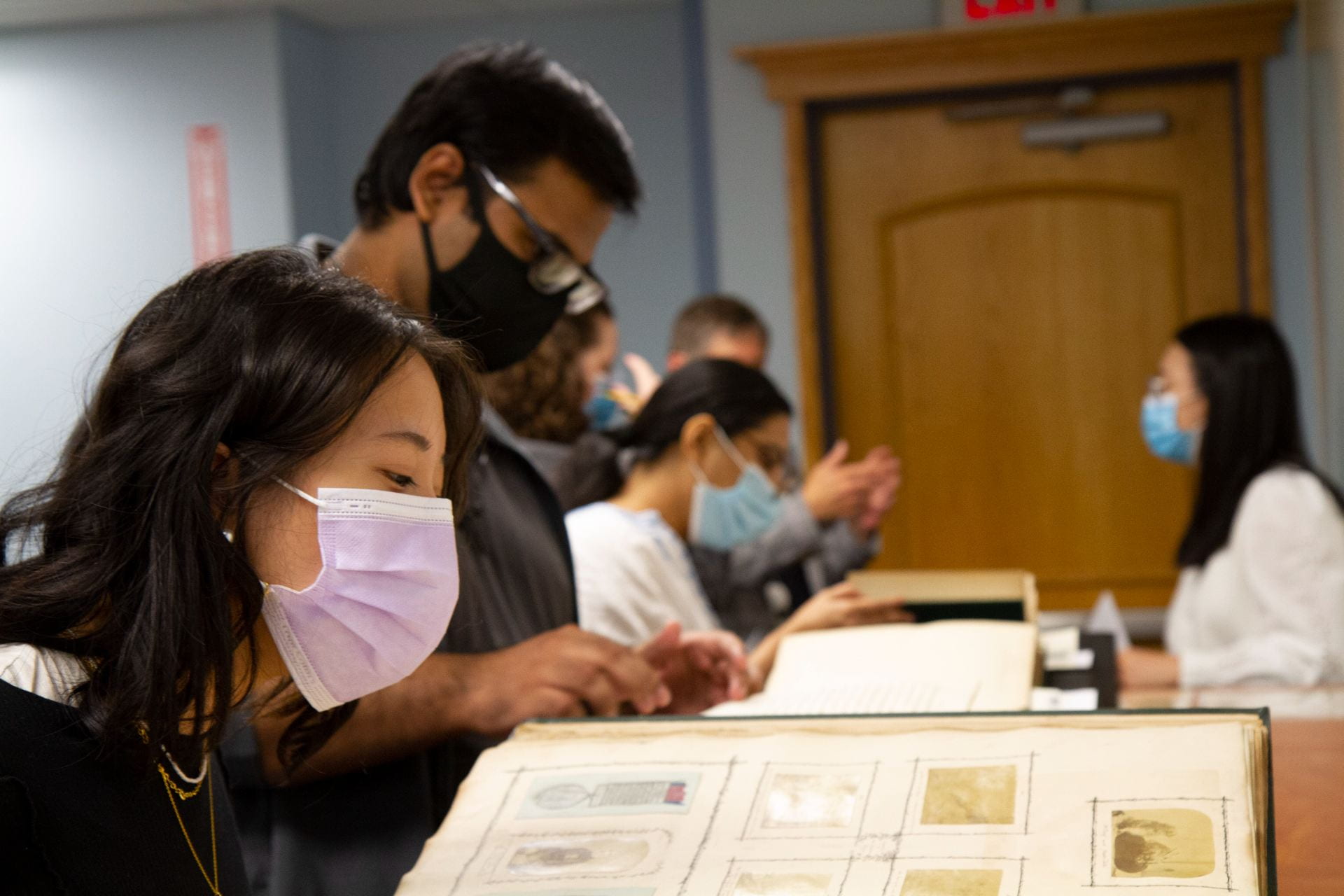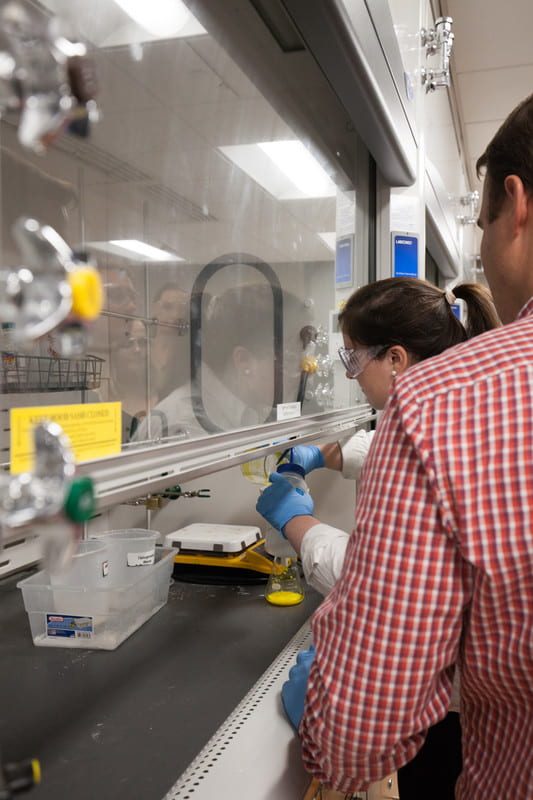Master’s in Art History
Requirements For the MA in Art History
The Master of Arts in art history provides students with a broad understanding of the history of visual culture and the methodological tools particular to art history as a discipline. As part of their studies, students develop two areas of specialization that prepare them for future doctoral study or employment in a variety of cultural institutions. It is in the spirit of this twofold mission, the development of a general art historical knowledge coupled with a more focused course of study, that students are asked to satisfy the following department requirements.

Admissions
Course Requirements
Candidates for the MA degree are required to complete a minimum total of 36 credits at the 400, 500, 600 or 800 level.
Students choosing to complete a thesis must complete at least 6 credits in thesis research (600 or 610). Students choosing to complete a scholarly paper must complete at least 18 credits in 500-level courses. Course requirements are as follows:
a. ARTH 551: “Historiography of Art History” (3 credits)
b. 27 credits at the 400 or 500-level, of which
-
- 3 credits must be taken in three of the following four areas of art history:
- Africa and the Middle East
- The Americas
- Asia and the Pacific
- Europe and the Mediterranean
- 9 ARTH credits must be taken at the 500 level (ARTH 551 and 596 may not be used to fulfill this requirement).
- 3 credits must be taken in three of the following four areas of art history:
c. 6 credits of ARTH 600 for a master’s thesis or 6 credits of ARTH 596 for a master’s paper. ARTH 596 may only be used by a master’s candidate for a master’s paper.
- Graduate students preparing for the Comprehensive Examination may enroll in either ARTH 496 or ARTH 596. Students may take up to 18 credits of ARTH 496 and up to 9 credits of ARTH 596. Exceeding the credit limit may result in courses not counting toward full-time enrollment and/or course credit satisfaction. PhD students who completed the MA at Penn State may find that LionPath counts ARTH 596 taken prior to matriculation into the PhD program toward the total allowed credits. Students uncertain about whether or not they have reached the maximum allowed credits for ARTH 596 are advised to consult with their assigned Graduate Enrollment officer.
Advisor
The Director of Graduate Studies (The Director of Graduate Studies for the 2023–24 academic year is Professor Nancy Locke) will advise all entering graduate students and any graduate students who have yet to choose an advisor. After entrance, master’s students are expected to select an advisor from the graduate faculty in art history before or during their second semester of study. This must be done in time for pre-registration for the next semester. The advisor is the faculty member who will supervise the student’s master’s thesis/paper. In addition, advisors will take an active role in a student’s course selection. Students are advised to consult their advisor on courses.
Foreign Language Requirements
Candidates must demonstrate a reading proficiency in one foreign language. The language relevant to the student’s area of study will be determined through consultation with the student’s faculty advisor, subject to the approval of the Director of Graduate Studies. Proficiency in this foreign language must be demonstrated before the end of the first year of study. Language examinations are administered within the department and consist of one-hour translations (with dictionary). You may arrange a language examination with an individual faculty member (please see Director of Graduate Studies for details). To test students who are studying languages for which we do not have an in house faculty member knowledgeable in that particular language we will accept a letter from a language instructor attesting to the fact that the student passed a translation exam (timed, with a dictionary). Native speakers of languages other than English who expect to use those languages in their research may request a waiver to the language exam from the Director of Graduate Studies.
The Scholarship and Research Integrity (SARI)
The Scholarship and Research Integrity (SARI) program is an opportunity for graduate students to engage broadly in a dialogue surrounding issues pertinent to research ethics. All new art history MA candidates are required to complete the SARI program in their first year of study. Their participation in and completion of the program will be monitored by the department’s Director of Graduate Studies. SARI training is included in ARTH 560 Methods of Research. Students not enrolled in the course may participate in the required SARI training in sessions.
Part 1: During the first year of enrollment, graduate students will be required to complete an online Responsible Conduct of Research (RCR) training program provided by the Collaborative Institutional Training Initiative (CITI). The Office for Research Protections (ORP) oversees this training, designated as “SARI @ PSU.”
Part 2: Graduate students are also required to engage in an additional five hours of discussion-based RCR education. These discussions will encompass both universal and discipline-specific material. Part 2 is normally conducted during the course of ARTH 551 Historiography and ARTH 560 Methods of Research. Graduate students may attend the relevant sessions even if they are not enrolled in ARTH 560 (ARTH 551 is a required course for MA and PhD students). In the event that ARTH 560 is not offered during a graduate student’s first year of study, the required SARI workshops will be held over the course of a few evenings and will be organized by the Director of Graduate Studies.
Art History’s Program for Part 2: Five Hours of Discussion-Based RCR Education
Hours 1 and 2: Responsible Authorship: Among the topics addressed are scholarly integrity, documentation standards, acknowledgments, research misconduct, collaboration, and mentor/trainee responsibilities. The Responsible Authorship unit is conducted by the professor teaching ARTH 560 and monitored by the Director of Graduate Studies.
Hour 3: Professional Conduct: This hour includes ethics and standards for writing resumes, grant proposals, and conference papers as well as practices of peer review, publication, negotiating contracts, interviewing human subjects, etc. The Professional Conduct session is conducted as a one-hour required workshop and is led by the graduate officer and one or two other faculty members chosen by the Director of Graduate Studies. Hour 3 may be conducted as part of ARTH 560.
Hour 4: Copyright and Reproduction of Images: This hour addresses the ethics and legal/copyright issues involved in using images for teaching, online education, theses, and publications. This workshop is conducted as part of ARTH 560 Methods of Research. If ARTH 560 s not offered in a given year, the workshop will take place during a one-hour required evening session led by the graduate officer, visual resources curator, and arts librarian.
Hour 5: Museum Ethics: This covers such topics as provenance, accessioning/de-accessioning, restoration, conservation, exhibition issues, dealing with living artists and heirs, etc. This workshop is conducted as part of ARTH 560 Methods Research. If ARTH 560 is not offered in a given year, the workshop will take place as a one-hour required session led by at least one Palmer Museum of Art curator and the Director of Graduate Studies.
Master's Examination
The Master’s examination must be taken before or during an MA candidate’s third semester of full-time study (not counting summers). There are two essay questions, representing two different fields. Students’ essays will assessed by specialists in each field (the same faculty member may not assess both essays). For each field, the student has a choice of one out of two essays. The essay for each field is a take-home, “open book” examination, written over one weekend (or the equivalent). For example, the student will be given the exam questions (choice of one out of two) by noon on a Friday, with the essay due by noon on the following Monday. The two different fields will be examined on two different weekends during the same semester (or summer). Although students have the weekend to contemplate their chosen question, the actual written response should be done in approximately a two-hour period and should be no longer than five printed pages (double-spaced). Each essay will be graded pass/fail. It is the student’s responsibility to make arrangements with individual faculty members to take the examination. A failed essay can be retaken once during the student’s fourth semester of full-time study (excluding summers). If an essay is failed for a second time, then the Graduate Programs Committee will decide if the student should be allowed to take the essay for a third time or be terminated from the program.
Students will complete essays in two fields. The fields and graduate faculty members for these essays are as follows:
- African art (Dr. Lauren Taylor)
- Oceanic art
- South Asian architecture and art (Dr. Desai)
- Chinese art and architecture (Dr. Tan)
- Pre-Columbian at and architecture (Dr. Solari)
- Ancient Egyptian art and architecture (Dr. Walters)
- Ancient Geek art and architecture (Dr. Walters)
- Ancient Roman art and architecture (Dr. Walters)
- Italian Renaissance art (Dr. Zolli)
- Renaissance Architecture (Dr. R. Thomas)
- Baroque/Rococo architecture (Dr. R. Thomas)
- Colonial Latin American art and architecture (Dr. Solari)
- Southern Baroque art (Dr. R. Thomas or Dr. James Harper)
- European and American architecture, ca. 1750-1900 (Dr. Zabel)
- European art, ca. 1780-1880 (Dr. Locke or Dr. Mansfield)
- European art, ca. 1880-1940 (Dr. Locke)
- American art to ca. 1940 (Dr. Rich or Dr. Robey)
- Architecture since ca. 1900 (Dr. Zabel)
- Art since ca. 1940 (Dr. Rich)
- Contemporary Art in Asia (Dr. Tan)
Master's Thesis or Paper
Students may choose to write a master’s thesis or paper.
Master’s Thesis Option: A master’s thesis must be completed according to the thesis guidelines of the University and is ultimately deposited in the Graduate School Thesis Office. A student choosing this option will register for 6 credits of ARTH 600, “Thesis Research,” during a single semester or split over two semesters, typically during a student’s second year of study. A successful thesis must be approved by at lest the student’s advisor and a second reader, all of whom must be members of the graduate faculty/affiliate faculty of the Department of Art History. Deadlines of a Master’s Thesis are set by the Graduate School, not the Department. Consult the Graduate School calendar for current submission dates.
Master’s Paper Option: A master’s paper does not need to follow the thesis guidelines of the University and is ultimately deposited in the department. A student choosing this option will register for 6 credits of ARTH 596, “Individual Studies,” during a single semester or split over two semester, typically during a student’s second year of study. A successful paper must be approved by the student’s advisor and a second reader, both of whom must be members of the graduate faculty/affiliate faculty of the Department of Art History. It is the advisor’s responsibility to establish reasonable format expectations for the paper. A “Signatory Page for a Master’s paper” can be found here. When the paper has been approved, it will be deposited with the Department Office for approval by the department he’d not later than one week before the end of classes for a given semester.
Additional University requirements for MA degrees may be found in Penn State’s University Bulletin.
